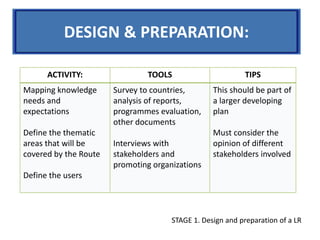SUN CSN - Learning Route Start-up meeting 2016 -8. design and systematization
- 1. 1. THE DESIGN AND PREPARATORY STAGE Case Study and Good Practices identification Giulia Pedone, PROCASUR, London, February 11, 2016
- 2. KNOWLEDGE: PREPARATORY STAGE STAGE 1. Design and preparation of a LR
- 3. DESIGN & PREPARATION ACTIVITY: TOOLS TIPS Mapping knowledge needs and expectations Define the thematic areas that will be covered by the Route Define the users Survey to countries, analysis of reports, programmes evaluation, other documents Interviews with stakeholders and promoting organizations This should be part of a larger developing plan Must consider the opinion of different stakeholders involved STAGE 1. Design and preparation of a LR DESIGN & PREPARATION:
- 4. STEP 1: Learning Objectives Fundamental principles of learning objectives: The Learning Objectives refers to the person who is learning, and not the goals or activities of the organizers of the training. They will be concrete, attainable and measureable. They should reflect the learning expectations of participants and be framed into the thematic areas previously identified STEP 1. IDENTIFICATION OF LEARNING OBJECTIVES: STAGE 1. Design and preparation of a LR
- 5. Improve knowledge of SUN member countries on best practices and successful initiatives in nutrition for their scaling up EXAMPLE OF GENERAL LEARNING OBJECTIVES: STAGE 1. Design and preparation of a LR
- 6. • Identify good practices to involve rural communities in the planning, implementation and monitoring of nutrition projects at community level; • Recognize efficient mechanisms for resource mobilisation; • Identify effective communication strategies to raise awareness on nutrition-sensitive issues and to promote behavioral changes EXAMPLE OF SPECIFIC LEARNING OBJECTIVES related to THEMATIC AREAS: STAGE 1. Design and preparation of a LR
- 7. TRY TO IDENTIFY LEARNING OBJECTIVES OUT OF THESE MAIN AREAS OF LEARNING EXPRESSED BY SUN MEMBER COUNTRIES 1. Policy review, policy tracking, communication, participatory/democratic processes 2. Engagement and stimulation of multi-stakeholder platforms 3. Budget tracking, advocacy, communication, data collection and sharing for monitoring and accountability 4. Advocacy social mobilization, campaign development, communication for accountability and awareness 5. Good governance, accountability and participatory processes EXERCISE: MACRO AREAS OF LEARNING STAGE 1. Design and preparation of a LR
- 8. An experience is relevant when it shows evidence of the use of good practices and/or innovations that have proved successful in addressing local challenges and to improve local people’s livelihoods/ nutrition. Improvement can refer to: a. Tangible dimension (physical assets, improved diet, nutrition standards) b. Intangible dimension (gender equality, social inclusion, political participation). STEP 2. SELECTION OF RELEVANT EXPERIENCES STAGE 1. Design and preparation of a LR
- 9. • The experience responds to the learning demand expressed by the LR users (SUN member countries) • Demonstrated to achieve sustainable results and have the potential to be adapted and applied to other similar contexts • It is possible to extract lessons that can be used to improve performance of other countries and organizations sharing similar challenges • KEY QUESTION: What good practices and/or innovative initiatives we can identify in the frame of the thematic areas prioritised by countries, to respond to their learning needs? STEP 2. SELECTION OF RELEVANT EXPERIENCES STAGE 1. Design and preparation of a LR
- 10. Main thematic area Identification of main programmes/ initiatives / strategies Learning expectations expressed by LR participants Key elements to be identified Key actors involved Promotion and articulation of social policies to reduce CCM Ex. Legal framework and decentralization strategies Design and implementation of multisectoral initiatives at institutional level Good practices and strategies to implement decentralised initiatives involving local governments Key stakeholders involved in these initiatives, their role in the process STAGE 1. Design and preparation of a LR EXAMPLE
- 11. STEP 3. SISTEMATIZATION “Systematize” means: to organize information in a systematic way. What we want to organize is the set of information, good practices and innovations that characterize a relevant experience developed by an organization, community, a formal or informal group, etc. We undertake the systematization together with the local people that are the key stakeholders that have developed the experiences. IMPORTANT: What we do it is not documenting technical innovations but to explain the PROCESS (the how, who, what) in order to be able to promote the scaling up of these innovations. STAGE 1. Design and preparation of a LR
- 12. During the “systematization process”, the key aspects of the experience are identified and analyzed by local practitioners. As conclusion of this process, the main information and learning are validated by the actors of the experience. The process of systematization aims to: a. Identify and analyze the key of success of the experience, its good practices and innovations; b. Extract lessons that can be applied for scaling-up the experience to other similar contexts; c. Facilitate appropriation of the learning by the actors of the experience and enhance their ability to share their knowledge. What are the objectives of a systematization process? STAGE 1. Design and preparation of a LR
Editor's Notes
- Main questions about systematization: What are the good practices? What are the innovations? Who are the groups that were involved? Who are the key individuals that were involved? How can the key actors be also involved in organizing the information about the experience?
- Main questions about objectives: What are the key aspects of the experience? Who were the main actors? What were the relationships between actors and institutions? What were the critical junctures in time? What are the good practices/ innovations? How can experience be scaled-up? How can people involved share their experience?











